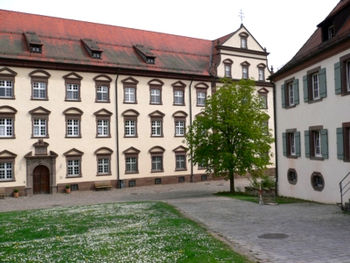
Kirchberg convent
Encyclopedia


Monastery
Monastery denotes the building, or complex of buildings, that houses a room reserved for prayer as well as the domestic quarters and workplace of monastics, whether monks or nuns, and whether living in community or alone .Monasteries may vary greatly in size – a small dwelling accommodating only...
located in Sulz am Neckar
Sulz am Neckar
Sulz am Neckar is a town in the district of Rottweil, in Baden-Württemberg, Germany. It is situated on the river Neckar, 22 km north of Rottweil, and 19 km southeast of Freudenstadt....
in Baden-Wuerttemberg, Germany
Germany
Germany , officially the Federal Republic of Germany , is a federal parliamentary republic in Europe. The country consists of 16 states while the capital and largest city is Berlin. Germany covers an area of 357,021 km2 and has a largely temperate seasonal climate...
. The monastery is considered to be one of the most historically important religious buildings in Baden-Wuerttemberg. It also ranks as one of the oldest, having been built in the early 13th century, and one of the first female church houses in central Europe
Europe
Europe is, by convention, one of the world's seven continents. Comprising the westernmost peninsula of Eurasia, Europe is generally 'divided' from Asia to its east by the watershed divides of the Ural and Caucasus Mountains, the Ural River, the Caspian and Black Seas, and the waterways connecting...
.
History
The Kirchberg monastery was built in 1237, on the site of a former castleCastle
A castle is a type of fortified structure built in Europe and the Middle East during the Middle Ages by European nobility. Scholars debate the scope of the word castle, but usually consider it to be the private fortified residence of a lord or noble...
. In 1245 the monastery was recognised by Pope Innocent IV
Pope Innocent IV
Pope Innocent IV , born Sinibaldo Fieschi, was pope from June 25, 1243 until his death in 1254.-Early life:...
.
Over roughly the same period, the number of nun
Nun
A nun is a woman who has taken vows committing her to live a spiritual life. She may be an ascetic who voluntarily chooses to leave mainstream society and live her life in prayer and contemplation in a monastery or convent...
s entering the convent went from around ten to sixty. This rise in the population of the convent can be credited in part to the apparent surge of 'religious awareness', with more women (of every class) wanting to live the life of a nun or at least one of piety in order to ensure that they remained spiritually healthy.
The convent continued its religious work for the next 500 years, despite the many changes that occurred in the area. However, after a secularisation that occurred in 1806, the monastery was virtually condemned to disuse: the nuns that were there were allowed to remain for the rest of their lives, but no more were allowed to join. The last nun left the monastery in 1865.
Today
Today, the monastery is used as any normal church house. It is the centre of the societies of the Berneuchen MovementBerneuchen Movement
Berneuchen Movement is part of the Lutheran Liturgical movement in Germany. It originates from German Youth Movement.The movement was born in 1920s, after the radical changes caused by World War I...
. Every morning, at 7:45am, a service of praise is held. At noon, a prayer service is held. Another is held at 6pm, and then at 9pm. These sessions are respectively known as Lauds
Lauds
Lauds is a divine office that takes place in the early morning hours and is one of the two major hours in the Roman Catholic Liturgy of the Hours. In the Eastern Orthodox tradition, it forms part of the Office of Matins...
, Sext
Sext
Sext, or Sixth Hour, is a fixed time of prayer of the Divine Office of almost all the traditional Christian liturgies. It consists mainly of psalms and is said at noon...
, Vespers
Vespers
Vespers is the evening prayer service in the Western Catholic, Eastern Catholic, and Eastern Orthodox, Anglican, and Lutheran liturgies of the canonical hours...
and Compline
Compline
Compline is the final church service of the day in the Christian tradition of canonical hours. The English word Compline is derived from the Latin completorium, as Compline is the completion of the working day. The word was first used in this sense about the beginning of the 6th century by St...
.
Celebration of Eucharist
Eucharist
The Eucharist , also called Holy Communion, the Sacrament of the Altar, the Blessed Sacrament, the Lord's Supper, and other names, is a Christian sacrament or ordinance...
also takes place at the monastery every Sunday and Thursday.
As of 2007, the minister of the Kirchberg monastery is pastor Peter Schwarz.

